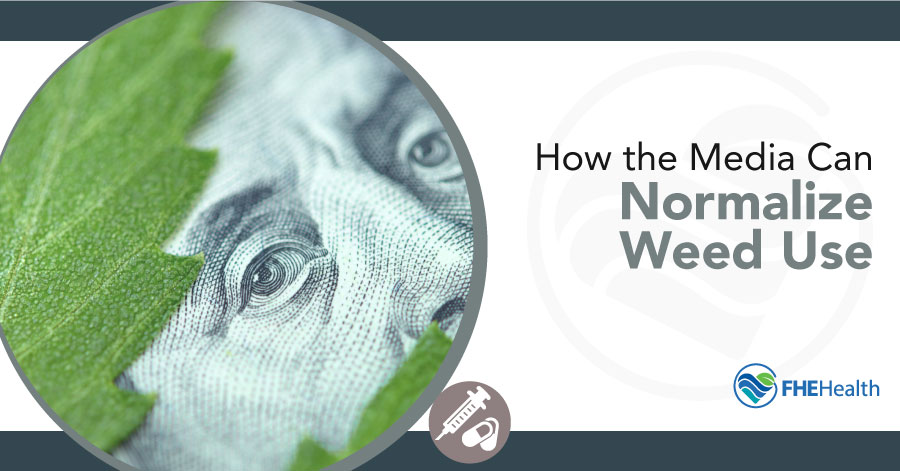
Updated July 18, 2023
It seems like marijuana use is everywhere you look today. It’s on television and in movies, as the focal point of discussions about legalization and legally used in more homes than ever before. And not only is it being talked about more, but it’s also gained a more widespread level of acceptance than in the past. This raises the question: How does the media influence drug use?
In this piece, we’ll discuss the changing trends of the last decade on marijuana acceptance and how public perceptions of the drug have changed. There certainly are consequences to this shift—both positive and negative. How does the acceptance of “weed culture” affect the rates of abuse and the number of people who develop health issues as a result of this behavior?
Contemporary Movie Depictions of Weed Use
Thanks in part to Hollywood movies and TV shows depicting stoner culture as cool, public acceptance of weed use is stronger than ever. After a hiatus due to COVID-19, weed in media is back in style with movies that include the following:
- The King of Staten Island (2020)
- Bob’s Burgers: The Movie (2022)
- Bill and Ted Face the Music (2020)
- Bad Trip (2021)
- Afterlife of the Party (2021)
What makes a good stoner culture movie? Aficionados say the characters must experience a questing arc. They’re searching for the best rocking party to enjoy the best time. These are buddy movies to the core. Stoned characters overeat, vomit, and engage in hypothetical and absurd conversations. Their exploits are comic, and everything is funny–or so it seems.
Three earlier Hollywood movies epitomizing stoner culture were Up In Smoke (1978) with Cheech and Chong, Harold & Kumar Go To White Castle (2004), and Easy Rider (1969) with Peter Fonda and Dennis Hopper.
Ironically, the fact that weed in media is now nonchalantly depicted has contributed to increased public acceptance of recreational marijuana use. All of which lead to changes in marijuana use legality. After all, people who write legislation reflect the voices of their constituents, the voters.
How Attitudes About Marijuana Use Have Shifted
Our knowledge and perception of marijuana have also changed dramatically over the past few decades. In the 60s and 70s, marijuana was part of a social movement, but it was still very much associated with a cultural minority. In the decades that followed, the focus on weed faded with the advent of much harder drugs — cocaine, crack cocaine, heroin, and opioid pain medications — and in the face of all this, cultural views of marijuana became more positive in comparison.
Today, there are countless news stories, threads on social media, and articles about marijuana showing it not as a danger but as a part of daily life in many places across the United States. And, as an example of media influence on drugs and alcohol, this exposure has led to marijuana use seeming more “normal” than ever before.
Weed Culture Has Become a Demographic
With the recent change in perception, people who engage in “weed culture” now have enough visibility to become a marketable group. Dispensaries actively advertise in states where the drug is medically or recreationally legal. Billboards, magazines, websites, and newspapers market different strains for certain purposes and varieties of experience.
The rise of marijuana users as a demographic has given even more credibility and acceptance to the behavior. This does have its benefits, but it’s not without potential drawbacks.
Positive Impacts
One of the primary benefits of decriminalization is fewer incarcerations for drug use. According to the ACLU, 8.2 million people were arrested for marijuana possession in 2010. People who abuse marijuana need help, not prison time.
Additionally, marijuana does have a therapeutic application for certain conditions. A study cited by the National Institute on Drug Abuse (NIDA) showed that states where patients can legally use marijuana for pain experienced lower rates of opioid overdose deaths.
Negative Impacts
There are also negative issues that emerge when a drug becomes normalized. First, when access to a substance increases, so does use in populations with a higher potential for abuse.
For example, it’s likely that unsafe teen marijuana use will continue to increase. Teen drug use statistics from the CDC show links between weed consumption and low performance in school, along with higher rates of mental health issues and addiction.
As another consequence of normalizing weed culture, publicized information and warnings about the risks of abuse tend to decrease. For example, many people are unaware of the potential for dependence or the hazards that may arise when marijuana is combined with other substances.
Plus, there’s less shame associated with using marijuana because it’s treated as safe. Instead, the shame falls on people who need help as a result of their marijuana abuse because legal and normalized substance use is thought of as harmless.
Weed Use Stats
According to a 2021 Gallup poll, 12 percent of adults in the U.S. smoke weed. 49 percent have tried marijuana, up from 45 percent in 2019 and 2017. Incredibly, that’s nearly half of all adults in America.
A record-high 68 percent of Americans told Gallup in 2021 that they support legalizing marijuana.
Other statistics show that the wide acceptance of weed is growing:
- 59 percent of Pew Research survey respondents indicated that marijuana should be legal for recreational and medical use.
- 22 states allow recreational and medical marijuana use (as of July 2023).
- The legal status of marijuana is fully illegal in four states: Idaho, Wyoming, Kansas, and South Carolina.
- In two states, North Carolina and Nebraska, marijuana use is fully illegal. There is no medicinal use allowed, although marijuana is decriminalized.
- Eight states allow weed for medical use, and marijuana is not decriminalized.
- Seven states allow CBD oil only for medicinal use, and weed is not decriminalized.
What Further Changes Can Be Expected?
Stoner culture notwithstanding, public perception and state- and federal policy changes on marijuana use legality are likely to continue. State legislatures that considered and rejected softening laws governing the various aspects of marijuana use react to changing attitudes and research by reconsidering statutes.
It could be argued that states with the most significant number of marijuana users (led by California) are primary motivators for the general acceptance of weed for recreational and medical use. Weed in media is another pervasive influence that shows no signs of abating.
California now has a law that protects most employees if they use marijuana when not at work. Previously, workers could be fired if they failed a drug test for cannabis metabolites. The new law takes effect on January 1, 2024. New York and New Jersey offer similar employment protections for users of cannabis.
Legal sales of marijuana to adult consumers in California began in 2018.
Societal norms continue to evolve regarding marijuana use, another result of stoner culture branching out nationwide. A new trend is a weed offered at wedding receptions, like an open bar, but for cannabis. Home delivery is available in some states in cities and counties permitting it. Likewise, hotels and restaurants in some states, like Colorado, set aside cannabis hospitality areas where patrons can enjoy weed.
Factors to Consider About Acceptance
There are some critical issues to keep in mind when considering how the media influences drug use.
Weed Is Getting Progressively More Potent
When marijuana first became popular in American society in the 1960s, it was much less potent than what’s available today. It contained a lower concentration of psychoactive molecules, so it had less of an impact on certain users.
Today, marijuana isn’t harmful per se, but it is much stronger. This means anyone prone to having issues with substance abuse and addiction can be triggered by smaller amounts of the substance.
Marijuana Use Disorder
You may have been told that marijuana isn’t addictive. This is only partially accurate, and it’s a potentially harmful claim.
Just because weed isn’t considered addictive in the traditional sense doesn’t mean you can’t become addicted to the way it makes you feel. This is what we call a behavioral addiction — like sex and gambling, using marijuana can cause a rush of pleasurable feelings you can become dependent on very easily. The increased potency of modern marijuana strains likely enhances this effect.
This condition is called marijuana use disorder, or MUD. People struggling with MUD often need to use the drug to feel normal and balanced mentally and emotionally. This means they likely stay under the influence for a major portion of the day, which can affect motivation and the ability to maintain a healthy routine.
While this doesn’t apply to everyone who uses marijuana, habitual users tend to be less able to hold a job and are more likely to experience financial insecurity and certain mental health issues.
These are the potential dangers we worry may be overlooked as weed use becomes more normalized.
When to Get Help
So how does the media influence drug use, and how can you be aware of this effect so you don’t fall prey to the risks of marijuana abuse? It’s important to understand that while the drug has been shown to have merits for some people, it’s not necessarily harmless.
With legalization and decriminalization becoming increasingly widespread, it’s likely that more first-time users will try marijuana without being prepared to handle the potential consequences. This makes it important that weed is still dealt with seriously, like alcohol. Just because something is legal and available, it doesn’t mean you can be overly casual with your habits.
If you or a loved one are using marijuana and you’re unable to stop, you may have developed a dependency. Contact FHE Health today and learn about your options to get the help you need.






